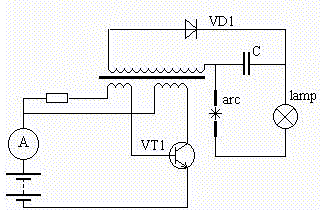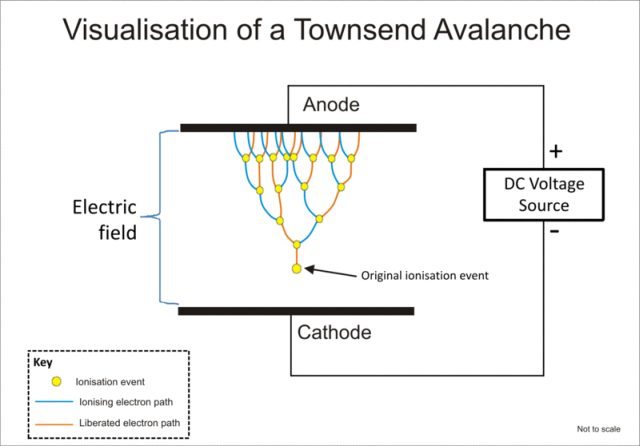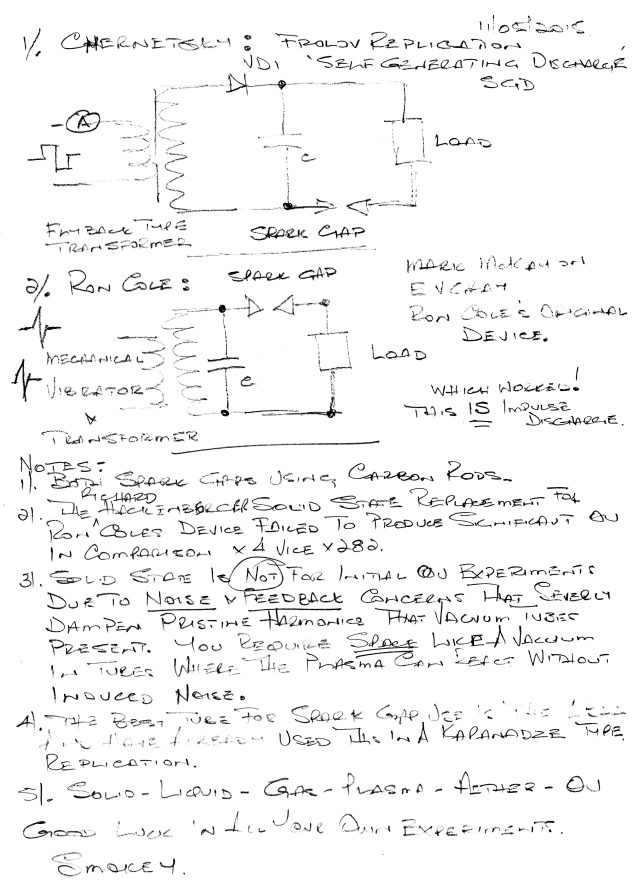

Hermes Atar Trismegistus
Between 1897 and 1901
John Sealy Edward Townsend
discovered the process of Free Energy, were free electrons are accelerated in
an electric field between two electrodes. As the electrons are accelerating they are
ionising more atoms that liberates more electrons that are moving toward
the anode (the positive (+)). The ionized atom moves toward the catode (the negative
(-)).This is known as the
Electron avalanche
also known as Townsend discharge.

Mark McKay has additional information about the Spark Gap and Free
Energy:
Your discussion of Townsend Avalanche theory as it relates to the Gray
Technology is missing two important aspects. The spark gap that is responsible for the
anomalous energy is exposed to large opposing magnetic fields as the distance between
the electrodes quickly increases. This was not the case in the CSET device and that is
not were the overunity was generated. The Bloch Wall of the magnetic interface appears
to have been located right in the middle of the arc plasma. This is a very complex
situation to analyze much less duplicate.
While the creation of additional free electrons is a well studied Townsend process the
overall impact of this operation is very much associated with the parameters of the
power supply as well. With more current carriers injected into the gap the effective
resistance drops - thus the negative resistance phenomena appears. What is generally
over looked is that this process doesn’t continue forever. It is limited by the
availability of untouched air atoms to which can be ionized. When the local supply of
these atoms is exhausted the process returns to the physics of a steady arc. In the
Gray system that doesn’t happen because we are talking about a short duration event
less than 10 milliseconds.
The overall response of the system depends upon having a constant voltage supply or a
constant current supply. Most people use a classical discharge capacitor which is
neither constant voltage nor constant current, thus the effects they are looking for
do not materialize.
Dr. Tesla specifically said in 1892 he used a constant current supply (HV generator)
in his original experiments to explore the beginnings of "Radiant energy".
Smokey has some theoretical design of the Ron Cole Impulse Discharge and
the Chernetsky Self Generating Discharge.


 Gary Porter vibrator
Gary Porter vibrator
In 1973 Edwin V. Gray became famous as the inventor of the
Free Energy motor called EMA that he recieved a patent for in June 17, 1975
USP 3,890,548 in which he disclose
a high voltage
sparkgap engine (3000 Volts).
The mechanical output was 275 times the electrical input! and in April 10, 1980 his
regenerative energy recovery system e. g. for electromagnetic propulation was
published as a UK patent application
GBPA 2,030,801
Norman Wootan Free Energy The History of The E V Gray Motor 2001
Peter Lindemann The World of Free Energy 2001
Eleven years later on June
17, 1986 . Gray recieved US Patent
USP 4,595,975 on a battery powered
powersource which output 4 times more energy than the energy contained in the battery.
Tesla's disruptive transformer with magnetic horn gap produced the silver
white aetheric fire via unidirectional DC pulses. Tesla even specified the rest period
of the firing pulses of .0062 millisecond. The conversion tube worked the same way!
 Tesla’s Spark Gaps: A Literature Review
Tesla’s Spark Gaps: A Literature Review
Almost one year later on April 28, 1987. Gray recieves US Patent
USP 4,661,747 for his conversation
tube.
Edwin V. Gray died of an heart attack in mysterious circumstances
1989, and with him died the technology.
Mark McKay, who have interviewed Gray's
children and other people dealing with the technology has made a timeline about Edwin
V. Gray and is avaible here in both gray.doc or
gray.odt and more information about the
Edwin V. Gray engine is avaible here: grayengine.doc
or grayengine.odt. Credits about the life of
Edwin V. Gray can be found here: credits.doc
or credits.odt. Here is some ideas about the
wiring of the EMA motor: delta.doc
or delta.odt. For more ideas how the EMA worked:
stretched.doc
or stretched.odt. An Electrostatic Energy Harvest
Method electrostatic.doc
or electrostatic.odt. The Phinney Trigger Circuit
phinney.doc
or phinney.odt. Converter Switching Element Tube
cset.doc
or cset.odt. Mysteries of the Timing & Control
Commutators timming.doc
or timming.odt. A Heuristic for the Detection of
Radiant Energy detection.doc
or detection.odt. A Heuristic for the Creation of
Radiant Energy creation.doc
or creation.odt. Supporting Classical Technologies
supporting.doc
or supporting.odt. The Mark W. Gray Interview
- 2007 mark.doc
or mark.odt. Interview with Dowd R. Cannady,
an E. V. Gray Observer cannady.doc
or cannady.odt. Edwin Vincent Gray, Sr. &
Family: Time-Line james.doc
or james.odt. The Mallory Connection
mallory.doc
or mallory.odt. The Crosby Research Foundation
crosby.doc
or crosby.odt. The Crosby letter
crosby.PDF
Mark McKay has the following information to share about the Edwin V. Gray technology:
1. The overall efficiency output of Gray Technology at its state of
development in 1973 was established to be 282 times the energy input (Coefficient of
Performance = COP). This was evaluated by two PhD. EE with extensive backgrounds in
power supplies. These tests were conducted for 10 days at Cal-Tech, CA using the best
instrumentation available.
2. The 6,000Hz device (Electrostatic Generator) was a failure. It was a transistor
version designed and built by Richard Hackenberger. It was designed to replace the
original Ron Cole device that employed a spark gap and mechanical vibrator. At best it
was advertised to have a COP of 4.0, but this was never tested by a 3rd party
laboratory. The original Cole "Black Box" operated at 100 Hz.
3. The circuit you describe is from the 1986 patent for the "Converter Switching
Element Tube". It is a custom device intended to control the anomalous "Cold
Electricity", it was not the source of that energy. This author believes that the
actual converter circuit was hidden in component #16 shown in your schematic as a
capacitor. Even so, these CSET devices were removed from the Free energy engine EMA6
in April of 1976. It is thought that they failed to operate at higher energy levels.
However, three capacitors( #16) remained with the engine.
4. None of the theory of operation you have in your report has been validated. In fact
much of it has been disproved in actual tests. The real heart of this technology is
still open for debate or experimentation.
In the early 1970's but in the
Sovietunion
Alexander V.
Chernetsky and his
friend Yuri Galkin expremented with a basically new type of a high frequency, high
current electrical generator. It gave out almost 5 times more electrical energy than
you put in.
 Alexander V. Chernetsky died in a
car accident in early 1990's and the secret of the Chernetsky
Plasma Generator died
with him.
Alexander V. Chernetsky died in a
car accident in early 1990's and the secret of the Chernetsky
Plasma Generator died
with him.
 Beyond Hydrogen: Discovery of Tiny New Atom Tauonium With Massive Implications
Beyond Hydrogen: Discovery of Tiny New Atom Tauonium With Massive Implications
Norm,
I'm having a little trouble understanding what Tiny New
Atom Tauonium can be used for? From what I understand, it reacts to electromagnetic
fields.
What if strong magnetic fields due to strong currents and low voltage
could be used to extract free energy?
It reminds of
http://gratisenergi.se/sparkgap.htm
and Alexander V. Chernetsky and Yuri Galkin superstrong current generator and many
other energy machines that use high current and low voltage.
Nikola Tela used a
single-ended 1 turn transformer when transforming his high voltage to low voltage.
What if we have been staring blindly at high voltage as a method of extracting free
energy?
What if all that is needed is low voltage and a relay to create plasma
current by breaking/closing the relay contacts? As in Ron Cole free energy generator?
Best Wishes, Hermes
Hi Simon,
Norm has not replied to my
questions about the discovery of the tiny atom Tauonium.
Is it possible to
exctract free energy from the Tauonium atom? and is very strong magnetic field like in
hot fusion necessary?
or could simply a magnetic field of many turns and much
current and a hollow iron core be enough?
Best Wishes, Hermes
Hi Hermes,
AFAICT this Tauonium is simply a particle and antiparticle in orbit
around each other. OK, saying "in orbit" isn't really a good term here, but it's the
one usually used for bound states such as electrons around protons, and makes it
acceptable to specify a size for the orbital. Difference here is that the orbital is
around 3.5 orders of magnitude smaller than the Hydrogen atom.
If you bind such
a particle and antiparticle together in an orbital, the properties cancel and you get
no net charge or net anything other than mass and energy. Thus this tauonium won't
have magnetic properties, in the same way that positronium (electron and positron in
mutual orbit) has no net charge or magnetic effects. You only see the +ve and -ve
charges when you get really close to them.
Thus as regards magnetic properties,
and what you can do with them, this will work the same as a neutral Hydrogen atom or
positronium. The main difference will be the density of the matter, with Tauonium
being about 1e+10 times denser than normal matter (and of course only available in
very small amounts close to the accelerators that make it). That extreme density and
small size, together with the lack of being able to hold it in a magnetic bottle,
means that you won't be able to hold the stuff anyway.
For low-voltage and
relays, bear in mind that breaking that low-voltage high current circuit results in
high voltage across the breaks because of the inductance, and thus produces sparks.
Reduce the capacitance across the gap to get the highest voltage in the sparks. Again,
not OU unless you trigger something else such as nuclear fission, which of course can
happen if you get the materials right and the conditions right.
So there's the
problem of dealing with Tauonium: making the stuff is currently only possible on a
chance basis, and the yield will likely be very low (they may not be able to reach
that 5-sigma threshold to be able to say they've reliably identified it). If you have
made it, then you can't hold something so small, dense, and with no net charge, so
it'll escape your experiment. Possibly it may last a while if the orbit stabilises the
tau and antitau, more likely it will decay in a small fraction of a second. Given the
cost of the kit required to make it, and the energy needed to run that kit, you'd
really need a massive yield to break even let alone get free energy, and that's if
there was any way to get more energy out of it than you put in, and there's no obvious
asymmetry there, at the moment.
Maybe not a good candidate to work on....
Best regards, Simon
back to linkpage
suggestion
read and sign my guestbook



